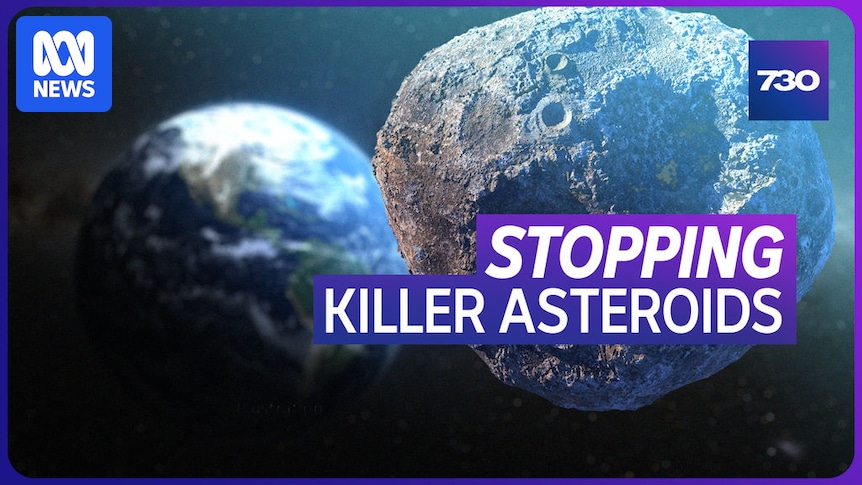FIONA WILLAN, REPORTER: As dusk falls in the WA bush the roof of the Zadko observatory rolls open, a robotic optical telescope stands ready to serve.
ASSOC. PROF DAVID COWARD, THE UNIVERSITY OF WESTERN AUSTRALIA: Ready, FA22.
We have 2025 FA22 right on target.
FIONA WILLAN: The Australian arm of the International Asteroid Warning Network is gearing up to defend the planet.
DAVID COWARD: This is a drill. Like any drill speed and timeliness is everything.
FIONA WILLAN: The drill is led by NASA and the aim is to test how quickly an international team of space experts can spring into action to guard the Earth should an asteroid come dangerously close.
DAVID COWARD: An asteroid is a space rock, and these rocks are orbiting the sun. And every now and again one of these rocks comes close to the earth.
FIONA WILLAN: While the threat they’re facing tonight isn’t real, the asteroid they’re preparing to track is.
EVAN DILLEY, TECHNICAL OFFICER, ZADKO OBSERVATORY: It’s pretty rare that something comes this close that’s this big.
The scenario put forward is that this object is going to have an 0.00001 probability of impact. That might not sound like a lot, but that’s probably about 300,000 times more probable than you winning the lottery.
FIONA WILLAN: Asteroids range in size from hundreds of kilometres in diameter to less than 10 metres. Most of the larger ones have already been discovered, it’s the smaller undiscovered objects that cause greater concern. We’ve seen how they can sneak up undetected.
In 2013, more than 1600 people in Russia were injured when an asteroid around 20 metres in diameter exploding in the atmosphere.
DAVID COWARD: We call some of these asteroids city destroyers. So that’s what planetary defence is protecting the earth from potential city destroyers.
EVAN DILLEY: It is a lot of pressure.
FIONA WILLAN: On the other side of the country is another key player in Australia’s asteroid warning team.
In Canberra, Ed Kruzins is preparing an optical telescope to track the fast-moving asteroid in the hours ahead.
PROFESSOR ED KRUZINS, UNSW CANBERRA: This is a sky map. What we’ve got here is the telescope controller, I can point to a particular part of the sky for example, I’m going to point there and I can tell the telescope to slew, so it’s moving right now above your head.
FIONA WILLAN: Is it?
ED KRUZINS: Yeah.
FIONA WILLAN: The asteroid is moving so quickly, astronomers will only have a short time to watch it.
ED KRUZINS: It’s moving at 38,000km per hour, that’s ten times the speed of a rifle bullet and the size of a skyscraper moving at that speed
FIONA WILLAN: The asteroid is approaching from the south and that means Australians are among the first to spot it.
The aim of this exercise is to gather as much information as possible as quickly as possible to send to NASA to help calculate its path.
If it really was a risk to Earth, that early information could be vital potentially even lifesaving.
Do you get nervous, do you get excited?
ED KRUZINS: You want to get it right.
FIONA WILLAN: And they do. In the early hours of the morning, their telescope captures the asteroid – seen here as a tiny speck among the stars.
If optical telescopes are the eyes of space surveillance you can think of radio telescopes as the ears.
We’re now at Canberra’s Deep Space Communication Complex. This is owned by NASA, but it’s run by Australia’s national science agency, the CSIRO and its scientists are also taking part in this asteroid-tracking mission.
KEVIN FERGUSON, CANBERRA DEEP SPACE COMMUNICATION COMPLEX DIRECTOR: We receive information from an optical group who will be the first to notice that an asteroid is out there in space. When that object becomes a little bit closer, then the radio side of observations occur.
FIONA WILLAN: These antennas are used to bounce a radio signal off the space object onto another antenna in a different location.
This can help scientists calculate its location, path, speed and composition.
KEVIN FERGUSON: Radar will take over and give more accuracy, more data. The radar works like anything, the speed of light, we use that speed of light as our main calculation. The closer it is, the shorter it will be in time for transmit and receive.
FIONA WILLAN: Dr Kelly Fast runs NASA’s planetary defence office from Washington DC.
DR KELLY FAST, ACTING PLANETARY DEFENSE OFFICER, NASA: We’re almost to 40,000 known near earth asteroids that we’re tracking, about 11,000 of those are over 140 metres in size, meaning they’re of a size that could do regional damage should they impact. And that is something that at NASA, we’re tasked by the US Congress to find and track those.
FIONA WILLAN: She is also leading this global drill.
KELLY FAST: Well, planetary defence, it’s been said, is finding asteroids before they find us and then I like to add that it’s maybe getting asteroids before they get us.
It’s the only natural disaster we could potentially avoid.
FIONA WILLAN: NASA scientists have proven it’s possible to reduce the risk of an impact. In 2022, they successfully pushed an asteroid off course by crashing into it with a spacecraft.
But it takes years of preparation to do this, and space agencies need to know the asteroid is coming.
So, drills like tonight’s will continue and astronomers will keep hunting for any new space threats.
DAVID COWARD: I think people should be confident that there’s planetary defenders out there looking after them.

